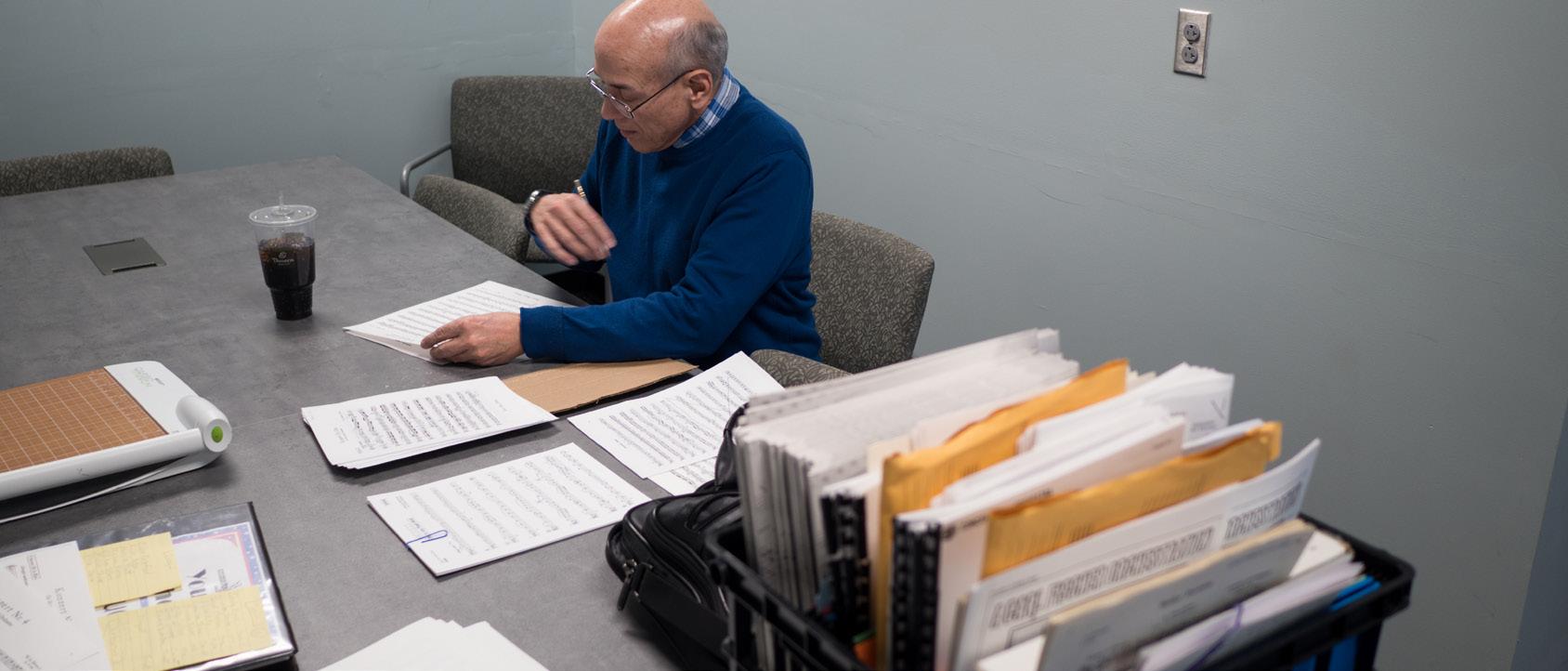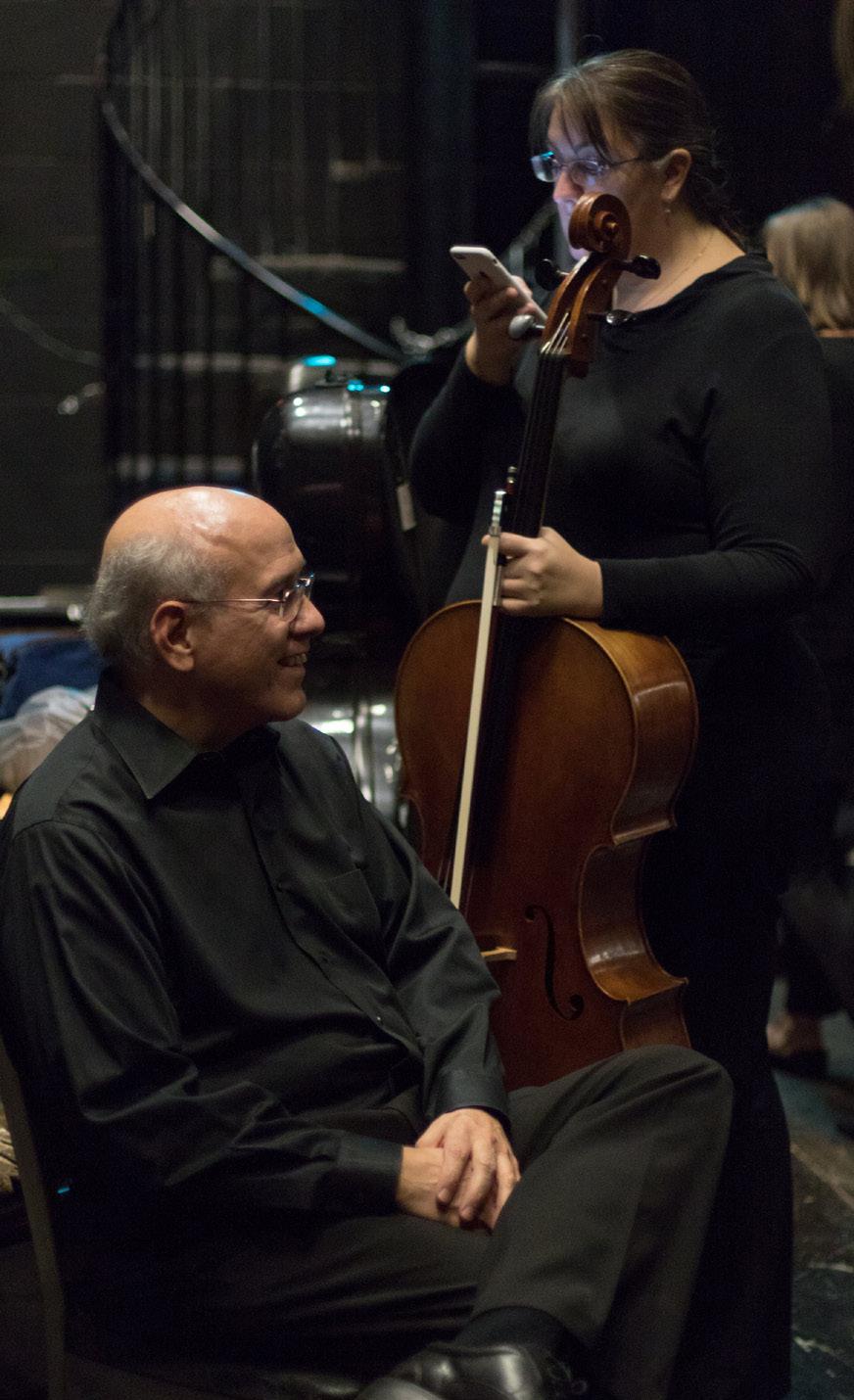
5 minute read
The Art of Music Librarianship


Advertisement
Top left: bowed sheet music; Bottom Left: Music Librarian Bob Borden preparing parts; Right: backstage Bob and Brenda Leonard (former Music Librarian and Principal Cello)
Preparing Sheet Music For Performance
Throughout our 93 years as an orchestra, the Spartanburg Philharmonic has amassed quite a music library. Our current Music Librarian Bob Borden keeps the collection organized and in good repair. However, this is only one aspect of the job. The librarian is also in charge of all the music passing through our musicians’ hands. Depending on the size of the orchestra for a given performance, this can be quite a feat. Unlike the conductor, who gets the full score for any music to be performed, each musician only sees their individual part. It often makes for a flurry of sheet music - one that Bob deftly manages well in advance of each concert.
Making sure each musician receives their music is only one part of a Music Librarian’s job, though. The work begins with acquiring the scores and parts if the piece is not already a part of the Philharmonic library, which means researching sources. Occasionally a piece in the public domain can be found online - many out of print scores and parts can be downloaded from the International Music Score Library Project (IMSLP) database - but frequently it must be purchased or rented from a publisher. Before finding the music, though, librarians work closely with the Music Director
“Orchestra Librarian is kind of an invisible job, but it’s quite detailed. Of course, some concerts were easy - an overture, concerto, and a symphony to rent, borrow, or buy and you’re all set. Get bowings from the concertmaster and the principal players, put them in the parts, and send out the music to the players.
On the other hand, if it’s concert with a lot of short pieces, it can be challenging to track them all down from various sources. I was librarian during Maestro Ioannides’s tenure and we did a lot of premieres. So, I was sometimes working with composers or publishers where the music wasn’t even finished yet!
Occasionally, Maestro wanted a piece that she had heard another orchestra play but wasn’t sure of the publisher. That could take some sleuthing to locate! On one memorable occasion, I ended up calling the principal librarian of the New York Philharmonic
and other artistic staff to determine which version, edition, or arrangement will be used. For example, for the Nutcracker - which we performed with Ballet Spartanburg this past December - there are dozens of versions of Tchaikovsky’s famous ballet. What you heard was the Golan Reduction, a version arranged for a smaller, pit-sized orchestra that stays true to the composer’s vision for the music.
Once the score is received, Bob can begin preparing the part for each musician. However, this is rarely a simple job as the sheet music is seldom ready for use “as is.” Being a music librarian is more than passing out and collecting folders. They also play a vital role in ensuring each rehearsal and performance’s seamless, smooth flow. This means adjusting the sheet music to accommodate each musician or soloist’s needs. Preparing the music often includes fixing ill-timed page turns, clarifying illegible notations (sometimes original from the composer), adjusting tempos, or even the entire key. Each part for strings also must be marked with bowings. Principal musicians (leader of an instrument section) decide the bowings for each instrument and are the first to receive the string parts from the librarian. From there, the principals make marks to indicate when the bow is to be moved up or down across the strings. Writing in bowings also helps ensure that a string section moves in unison. After receiving the marked parts from the principals, the music librarian hand copies the markings into the the rest of the string sections’ parts.
Typically a single orchestra concert features at least 4-5 pieces for a 90-minute program. However, more music is required when the pieces are shorter, which means much more preparation for the music librarian. For our Magical concert featuring the music of John Williams, there were 14. That’s a lot of sheet music! Because so much is involved in preparing the music for a single concert, Bob begins his work just as soon as the programs are decided. So this March, when we officially announce our 2022/23 Season - Bob will have already started sourcing the sheet music for each piece featured in the concerts.
On a final note, historically, both for the Spartanburg Philharmonic and similarly sized orchestras, the Music Librarian is frequently also an ensemble member. Interestingly, string players have also primarily held the position, already familiar with marking bowings. Up until Bob Borden, this was also true for the Philharmonic. We have been fortunate to have several incredible Music Librarians over the organization’s history — each one playing a vital role in making performances happen for each of you to enjoy.
trying to track down their arrangement of a pops tune! He was very nice — really, in my experience, most orchestra librarians are nice. It’s a very small community and people try to help each other.”
Brenda Leonard
Former Music Librarian
for the Spartanburg Philharmonic










